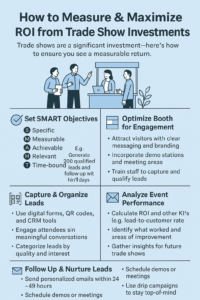💼 How to Measure and Maximize ROI from Trade Show Investments
Trade shows are one of the most effective platforms for connecting with potential customers, launching products, and strengthening brand visibility. Yet for many businesses, understanding how to measure and maximize ROI from trade shows remains a challenge. If you’re investing significant time and money into trade shows, it’s crucial to ensure those investments deliver tangible business results.
This comprehensive guide explores everything you need to know about improving and calculating , helping you turn your event presence into measurable business growth.
📊 What Is ROI from Trade Shows and Why It Matters
Understanding ROI from Trade Shows
ROI from trade shows refers to the return on your investment relative to the cost of participating in an event. While many organizations focus solely on sales, true trade show ROI includes a wider range of outcomes:
- Direct revenue (sales closed at or after the show)
- Lead generation and quality
- Brand awareness
- Strategic partnerships
- Long-term customer engagement
Recognizing both immediate and indirect returns helps paint a more complete picture of your success and informs future trade show strategy.
Going Beyond Sales: The Full ROI Spectrum
Immediate sales are great—but focusing only on revenue leaves out other key drivers of ROI from trade shows, such as:
- Number of qualified leads collected
- Increase in website traffic after the event
- Social media engagement and brand mentions
- New contacts and partnerships initiated
- Attendee engagement and booth interactions
Tracking and assigning value to these elements offers a more accurate evaluation of trade show performance.
🧭 Pre-Show Planning: The Foundation of Maximizing ROI from Trade Shows
Set SMART Objectives and KPIs
To accurately measure ROI from trade shows, define your goals using the SMART framework:
- Specific: e.g., collect 100 qualified leads
- Measurable: trackable KPIs like cost per lead
- Achievable: based on your past event data
- Relevant: aligned with business goals
- Time-bound: e.g., follow up within 5 business days
KPIs to consider:
- Number of leads generated
- Engagement rate
- Number of demo requests
- Follow-up meeting conversions
Identify Your Target Audience and Engage Early
The better you understand your audience, the better your engagement—and the better your ROI from trade shows. Use pre-show marketing (email campaigns, LinkedIn messaging, social promotions) to:
- Attract the right people
- Book appointments before the show
- Build anticipation for your booth
Optimize Booth Design and Staffing
An eye-catching booth that aligns with your brand is vital for attracting traffic. Focus on:
- Clear messaging
- Interactive elements
- Demo stations
- Comfortable meeting zones
Your staff should be trained not just to greet, but to qualify leads, answer questions, and collect relevant data. This enhances lead quality and impacts your post-show conversion—and ultimately, your ROI from trade shows.
🤝 During the Trade Show: Capture, Engage, Convert
Implement Strategic Lead Capture
Use technology like:
- QR code scanners
- Digital forms
- Interactive kiosks
- Mobile CRM integration
This ensures clean, organized, and actionable data for follow-up—essential for tracking and maximizing ROI from trade shows.
Build Real Relationships on the Floor
Don’t just sell—connect. Build rapport by listening, asking meaningful questions, and understanding each attendee’s challenges. Strong booth interactions directly influence future engagement and conversion rates.
Stay Organized with Real-Time Data Logging
Categorize leads by quality and interest. Capture notes immediately to personalize future communication. This level of organization significantly increases your chances of follow-up success, impacting long-term trade show ROI.
📈 After the Show: Analyze and Maximize ROI from Trade Shows
Follow-Up Fast and Smart
Prompt, personalized follow-up is where the real work begins:
- Email within 24–48 hours
- Reference your booth conversation
- Offer value: a downloadable, demo, case study, or meeting
- Use drip campaigns to nurture
Speed, relevance, and consistency are key to converting leads into revenue—and unlocking your full ROI from trade shows.
Analyze Your Performance: Metrics That Matter
Use CRM and analytics tools to calculate your returns. Key metrics include:
- Total cost per lead
- Lead-to-customer conversion rate
- Revenue generated per event
- Customer lifetime value (CLV) from trade show leads
ROI from trade shows = (Revenue – Costs) / Costs x 100
Example:
- Revenue from deals = ₹10,00,000
- Total spend = ₹2,50,000
- ROI = (₹10,00,000 – ₹2,50,000) / ₹2,50,000 × 100 = 300%
Create a Post-Event Report and Refine Your Strategy
Evaluate what worked and what didn’t:
- Which marketing efforts drove the most footfall?
- Which staff members had the highest conversion?
- Which activities had the best cost-efficiency?
Document these insights in a post-show report. This becomes your blueprint for improving ROI from trade shows at future events.
💡 Pro Tips to Maximize ROI from Trade Shows
- Pre-book meetings with prospects using show platforms
- Train your team for better engagement and qualification
- Incorporate live demos and interactive tech to boost booth visits
- Share on social media during the event to increase visibility
- Use giveaways strategically to collect relevant leads—not just traffic
- Retarget website visitors who came from event-specific landing pages
✅ Conclusion: ROI from Trade Shows Is Measurable—and Scalable
Trade shows are a major investment—but when done right, they offer incredible value. From defining smart goals and capturing quality leads to strategic follow-up and performance analysis, every step plays a role in boosting your ROI from trade shows.
Don’t treat trade shows as one-time expenses. With the right systems and strategies in place, they become scalable marketing machines that fuel long-term business growth.
👉 Ready to improve your ROI from trade shows? Start planning smarter, track every lead, and measure what matters.

